Issue#
Application Module
Primary Function
Detail
Enhancements
EBT-39
File Processing
EBT
SPIRIT sends APL, Category/subcategory, and Authorized Vendor batch files to the EBT Processor on a scheduled and on-demand basis. When the EBT Processor receives a file, it is processed and a return file is sent to the Chickasaw FTP site with the processing results. These results include error codes indicating successful or erroneous processing for the header and detail records.
The EBT Processor has indicated that this processing could take up to 20 minutes before a return file could be sent. Since it is not practical to stall the SPIRIT application or End of Day Processing for this length of time, a new solution has been devised to determine the results of batch file transmissions.
The return files from the EBT Processor are now processed by the Windows service at the application server and the results are sent to the EBT Notification List entries for the new process type, "BatchFile". This service periodically checks the Chickasaw FTP site to see if there are return files to be processed. If there are, the service will read through the file to determine results, record the results in the database, and send an e-mail to the user(s) indicating the results of the file transmission.
The Windows service is a stand-alone application installed on an application server. It includes a timer using an interval from the EBTCONNECTIONINFO table. This timer (initially set to 10 minutes) signifies the number of minutes to wait before checking the FTP site again.
This solution for monitoring return files no longer stalls the online application or the End of Day Process for the length of time it could take to receive a return file from the EBT Processor. It only affects the way return files are handled; there is no change to the files being sent to the EBT Processor.
EBT-41
Clinic
Work with On-site Group
The Work with On-site Group screen has been modified to allow group issuance with EBT. Previously, this screen allowed sets of checks to be issued for an on-site group, but several modifications were needed to accommodate EBT. The batch issuance process will now be conducted as follows:
Participants will be marked as on-site using the Toggle On-site menu item or EBT Search by PAN Number functionality.
The Work with On-site Group screen will be displayed.
When the Issue Benefits check box is selected, SPIRIT will attempt to issue benefits to the selected on-site participants.
The process has been modified to take current regulations and issuance rules into account when issuing benefits to participants on-site. The Aggregated Issuance for EBT Account screen will be displayed for each set of benefits to be issued.
The process has been modified to handle the EBT Processor communication standard error messages, the EBT Processor data errors, and households with pending EBT issuances. Code was added allowing users to retry the batch issuance in the event of a communication failure. In such event, users will be able to attempt the batch issuance again by launching the Work with On-site Group screen and selecting Issue Benefits. SPIRIT will determine which participants still have benefits that need to be issued and will attempt to issue those benefits as before. SPIRIT will also attempt to resolve any pending issuances that exist as a result of any previous communication standard error messages.
The Work with On-site Group screen has been modified to display success/standard error messages. If participants do not have benefits available for issuance, SPIRIT will display a message to notify the user. If there is a the EBT Processor data error, SPIRIT will display the message and continue with the next issuance. All issuances and/or standard error messages will be logged in the Event Log - Work With On-site Group. (See Figures below.)

Figure 1 - Work with On-site Group screen and Error Message
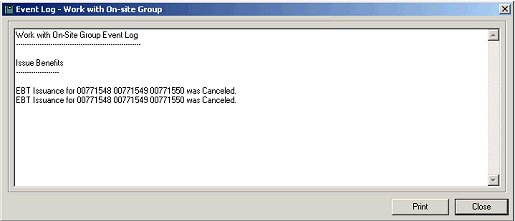
Figure 2 - Event Log - Work With On-site Group screen
ENH-1 / MN-304
Clinic
Risk Factor Definitions
The Nutritional Risk processing within SPIRIT has been modified to reflect Revision 10 updates incorporating 2009 IOM revised recommendations. Multiple Risk Factor definitions have been revised, the screen layout has been modified on the Health Information screens for both Women and Children, and new check boxes were added. Risk factors will be assigned based on these new check boxes, as well as using new assignment thresholds. These modifications affect the Health Information and Risk Factor Assignment functionality in both the Certification Guided Script and Participant Folder in the Clinic application. The new screen layouts will be visible in both Central Administrative Site and State Office versions of the Clinic application as View Only.
Additionally, the code was modified to match the DFDD for postpartum women. If a participant is non-breastfeeding or breastfeeding and is in the first 6 months postpartum, the lesser of the pre-pregnancy weight and current weight will be used. If a participant is breastfeeding and is past the first 6 months postpartum, the current weight will be used. If the BMI is less than 18.5, Risk Factor 101 will be assigned.

Figure 3 - Child Health Information screen
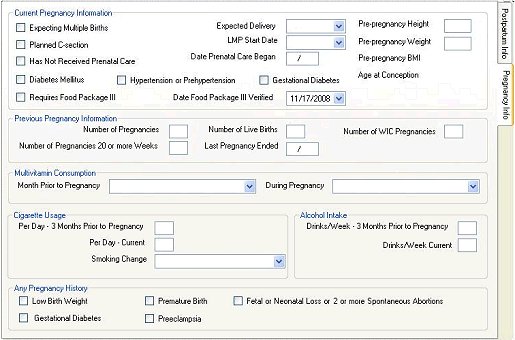
Figure 4 - Pregnancy Information screen
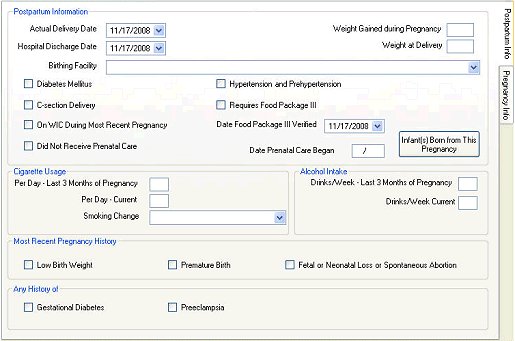
Figure 5 - Postpartum Information screen
ENH-7
State Office, Financial Management
Reports
A new Year-to-date Participation and Outlays Report FIN017 (Output) (FIN-017) has been added. This report lists the participation breakdown as it is shown on the new FNS-798 report for each month of the fiscal year including the current month-to-date. It shows the month-by-month count of participants and total of outlays for participants who were issued at least one food instrument. Payment data includes checks, vouchers, EBT, and direct distribution.
The report has been added to the Generate Reports screen in the Financial Management application and to the Generate Reports screen in State Office applications. A new Generate Year-to-date Participation and Outlays Report screen has been added. This screen allows the user to select the following report parameters:
Fiscal Year
Participation Month
Level of Reporting (Clinic, Grantee, Local Agency, or State)
Report Destination (screen, printer, or PDF)
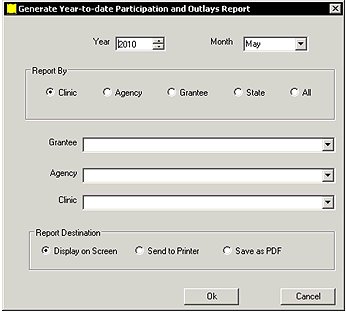
Figure 6 - Generate Year-to-date Participation and Outlays Report screen
Note: This report has been tested only at the State level, and only against checks. It has not been tested using vouchers, EBT, or direct distribution.
ENH-167 / SUG-540
All
MOWINS Splash screen
The splash screen has been changed to display the MOWINS banner and logo instead of SPIRIT for Missouri. This screen is presented on selection of the Help About menu item within each of the SPIRIT application modules. A business rule has been added to the SPIRIT application to implement this change.

Figure 7 - MOWINS banner and logo
Note: The splash screen is presented before the user has been able to log into the database. In order to determine which logo to display, the system looks at the client-specific URL. For Missouri, the system looks for the string "MOWINS" anywhere in the URL. For Minnesota, the system looks for the string "mnwic.net". For Montana, the system looks for the string "MT.gov". Because each and every client-specific URL cannot be reproduced in testing environments, you may see a SPIRIT splash screen on the Help About screen instead of one for your specific state.
VND-18
Vendor
Vendor Price Survey
An Online Vendor Price Survey application has been added. It can be utilized by Vendor Managers to create templates for use by vendors and corporate parents. These templates allow authorized vendor prices for food distribution items to be established. Once a vendor manager has created a template, it can be sent via e-mail invitation to vendors and corporate parents. Vendors and corporate parents can then access the application via a link in their e-mail invitation, enter verification information, and submit their prices to the survey.
Users will access this application by selecting the new Send Online Price Survey menu item from the Vendor List menu:
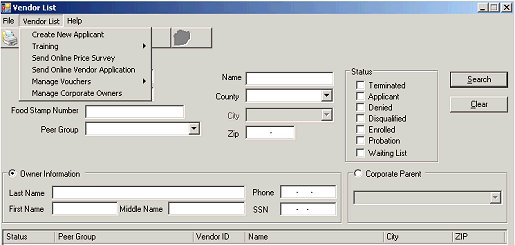
Figure 8 - Vendor List screen
The Online Vendor Price Survey application consists of multiple screens. When first launched from Vendor List, users can access all functions in the Vendor Price Survey using the menu bar on the left-hand side of the screen. The following menu options are available:
Define Templates
Send Invitation to Vendors
Send Invitation to Corporate parents
View Invitation Sent
View Pending Price Survey
Site Help
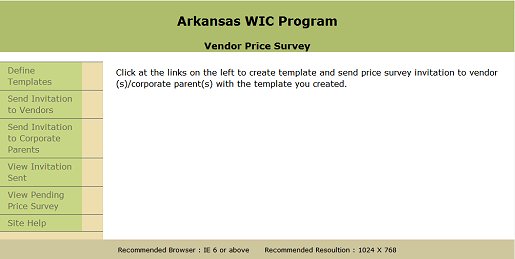
Figure 9 - Online Vendor Price Survey (initial screen)
The following features are present in the Vendor Price Survey:
The Price Survey will display only active food items.
The display will group food items by their associated Base Food Category.
All food item prices can be modified from a single screen.
Peer Group food item prices can be edited from a single screen.
Prior Price Surveys are available for review.
The Price Survey invitation includes the option to send a single e-mail to the Corporate Parent for multiple Vendors.
The Items surveyed are customizable to accommodate varied Vendors.
Users are able to view invitations that have been sent and those pending a response.
The Price Survey provides an option to preselect the prior Vendor surveyed prices for inclusion or to request that all new values be entered.
The Vendor has an option to download an Excel version of the Price Survey instead of entering the values online.
The Vendor has an option to upload the values from the Excel version to the website.
Note: The Online Vendor Price Survey application is only supported for Internet Explorer. It may not be compatible with other web browsers.
Reported Issues
CNEBT-27 / CNEBT-35 / CNEBT-53
Clinic
EBT Household Change Guided Script
Issue: When the EBT Household Change Guided Script is used to move a participant from one household to another and the EBT Account Balance is printed, the Issue Benefits screen for the initial household still displays the transferred participant as the Primary Cardholder.
When moving a child from one household to another, deleting the former authorized representative for the household, and changing the authorized representative to the new household, an EBT Processor Interface Transaction Error DT22 occurs.
When a household has a child participant and authorized representative where the authorized representative is the primary cardholder, the Change Household ID process is prompting for the Authorized Representative's date of birth during the Remove Cards step 3.
When moving a participant from one household to another and attempting to remove cards, an EBT Processor Interface Transaction Error DT75 occurs.
Resolution: Both the new and existing household records stored the transferred participant as the primary cardholder in the UAT database. When the household change occurred, the old cardholder was not being removed. The logic was changed to remove a cardholder as step 3 of the Change Household ID process. Step 3 of the process was also modified to populate the date of birth for the proxy cardholder.
Code was added to handle DT75 transaction errors when querying for a household that does not exist in the EBT Processor system.
The process has been modified to avoid receiving DT75 errors. Modifications were made to ensure data integrity of the Participant and Household following the Change Household ID process. All non-DT75 errors were a result of data not being refreshed following this process.
CNEBT-28
Vendor
Vendor Disqualification
Issue: The vendor deactivation record is not being sent to the EBT Processor on the deactivation date. The system process is sending the termination to the EBT Processor with the next batch after the record is modified.
Resolution: The system process will now only send terminations when the bank termination date falls between the last batch and the current one.
CNEBT-32
Vendor
Vendor Return File
Issue: When the vendor file was sent to the EBT Processor with the End of Day process, two standard error messages were associated with the vendor file due to missing data.
Resolution: The contact name on the rejected records was populated with a value of "unknown" in lowercase letters when the corporate authorized agent was null or blank. The EBT Processor does not accept this as a valid contact name. The accepted value for null or blank records is "UNKNOWN" in uppercase letters. A change was added to the database scripts to accommodate this requirement.
CNEBT-47
Clinic
EBT Household Change Guided Script
Issue: When transferring a participant to a non-EBT clinic using the EBT Household Change Guided Script, users are unable to edit the date of birth for an authorized representative with an assigned card. The following standard error message is displayed:
Invalid/Missing Primary Cardholder Date of Birth
Resolution: The Household Members data grid of the EBT Household Demographics screen has been unlocked so that users can assign a date of birth to the Authorized Representative.
CNEBT-51
Clinic
Food Adjustment Wizard
Issue: When returning cans of formula via the Enter Return Quantity screen of the Food Adjustment Wizard, the process always rounds up the values if the old formula and new formula have different reconstituted values. These values should only be rounded up at half cans.
Resolution: A modification has been made to ensure that when a new formula has a different reconstituted value, the system will round up at half cans (.5) or more. It will round down if it is less than.5.
CNEBT-74
Clinic
Formula Replacement
Issue: The Formula Items data grid row in the Formula Replacement screen disappears when users attempt to return all cans of formula that have been issued. The row appears correctly if the quantity returned is less than the maximum issued.
Resolution: A line of code was removed that prevented Formula Items data grid rows with 0 cans available from being displayed in the Formula Replacement screen.
CNEBT-83
Clinic
EBT Benefit Issuance
Issue: SPIRIT is printing quart and half gallon food distribution items on the Benefit Report (Output). It is correctly issuing to only gallon food distribution items, and is showing the correct issuance amount on the Account Balance Report (Output).
Resolution: The initial requirement to show quarts and half gallons on the shopping list printed from SPIRIT has been removed. Milk will now be displayed on the shopping list in decimal gallons. Printed shopping lists will now match the Aggregated Issuance for EBT Account screen and what was issued to the EBT Processor. The following key was added to the bottom of the report:
Milk Conversion:
.75 = 1 quart and 1 half-gallon or 3 quarts
.5 = 1 half-gallon or 2 quarts
.25 = 1 quart
CNEBT-84 / CNEBT-95
Clinic
Food Adjustment Wizard
Issue: The Food Adjustment Wizard does not allow the replacement of decimal parts of food items (i.e..5 lbs of cheese). Also, it only allows cheese to be replaced with cheese rather than with milk, soy, or tofu.
Resolution: A change was made allowing users to enter decimal amounts. Additionally, users can now replace the cheese with milk, soy, or tofu.
CNEBT-86
Clinic
Food Adjustment Wizard
Issue: In the Food Adjustment Wizard, there is no category for cheese and no way to remove cheese from the current benefit and add more milk.
Resolution: The milk and cheese categories were combined on both the Food Category and Replacement Food screens. The missing mapping for milk substitutions was added. Additionally, the issuance was changed to send the units of measure in gallons only for all milk products. The Food Adjustment Wizard was changed to assume all milk products are in gallons.
MN-263 / SUG-820
Clinic
Participant List
Issue: Using the arrow key to search through the Participant List results in locking up the web server. Error messages are displayed. This condition causes IIS to have to be manually restarted to regain access to the system from any PCs running against the locked web server.
Resolution: The previous code used a SelectionChanged data grid event and was firing 6 or more times on each row change. Each event fire calls web services. Quickly scrolling through 10 rows using the arrow keys could be queuing up to 60 or more web calls. The code was changed to use the CurrentCellChanged event. This event is called only once per row change.
SQL queries were moved out of the web service and are now called via stored procedures and native .net SQL methods instead of DBHelper calls. Both the client and server side code has been optimized when displaying Participant List details.
These changes ensure that the web server is no longer locked up when an attempt is made to scroll through multiple participants listed on the screen with Show Details in view mode. This includes holding down the arrow keys or hitting the arrow key many times in rapid succession.
MN-450
Clinic
Reprinting Benefits
Issue: When benefits are reprinted, the quantities are represented with an additional two decimal places. This adds three characters to the length of the string, causing the text to run together.
Resolution: A change was made to suppress decimals on checks unless they are meaningful (i.e. 1.5 lbs of cheese). Whole numbers will be displayed as integers. Space was added between the decimal places and text resolving the issue, but leaving room to show decimal places on checks if benefits are issued as anything other than whole numbers.
SUG-73
Clinic
Food Prescription
Issue: The Food Prescription for BF Women with Multiples is displaying the cheese amount as 3.6 instead of 3.5 lbs. This prevents the maximum amount of milk products from being issued.
Resolution: Values with.6 were occurring in the Participant Folder due to an issue with the GetMaxQtyAverage() function. This issue caused values to be correct only on even months. This issue does not occur in the Certification Guided Script since for a new certification, the average calculation is always for a minimum of 6 months. GetMaxQtyAverage() was reworked to use the same method as on the Details screen. The Details screen also calculates and displays the max quantity average, but does not suffer from this odd-number bug. Code was added to GetMaxQtyAverage() to calculate the average differently for non-formula food items using the code from the DetermineDistribution() function used by the Details screen.
SUG-698
Reference Utility
Maintain Agencies
Issue: Users are unable to enter three (3) digits in the Clinic ID Number field when adding a new clinic ID to an agency.
Resolution: The maximum number of digits for an Agency or Clinic (Service Site) ID is controlled by the state business rule: AGENCY_SITE_LENGTH. Code was added to the frmupdateClinic screen to check this business rule.
SUG-729
Clinic
Income Calculator
Issue: Changes to the Pending Proof of Income check box on the Income Calculator screen is applied only to the current participant. These changes should be applied to all members of the participant's household since income contacts are now handled at the household level.
Resolution: Code was added to include the IsPendingProof value when copying values from the current participant to other household members. This will now create a new CPA Alert for all participants of the household stating that their income is pending.
SUG-792
System Administration
Data Sync
Issue: When attempting to check out a clinic on the server laptop, a message displays during the save operating stating: Incorrect syntax near ')'.
Resolution: A modification was made to remove the extra '.' in the INSERT for HealthNotes.
SUG-800
System Administration, Clinic
Data Sync
Issue: When checking out a clinic, the data sync completes without any problems. But, when opening the Participant List, the following standard error message displays:
Cannot insert the value NULL into column 'LOGENTRYID', the table 'MSPIRIT.dbo.SYSTEMACCESSLOG'; column does not allow nulls. INSERT fails.
Resolution: A patch was created to enable Data Sync to work with a named instance of SQL Server on a data sync laptop (DataSyncNamedInstancePatch.zip). There are two files to install on the laptop where SQL Server 2008 R2 is not the default instance. This patch is to be manually applied to an installed SPIRIT WIC Client. It will be automatically overwritten if a newer version of SPIRIT is installed on the Web Server and Automatic Software Updates is enabled on the WIC Config Editor for the WIC Client.
SUG-806
Vendor
XML Files
Issue: Three local reference data XML files have been identified as containing confidential vendor related data. All users of SPIRIT have the XML files regardless of whether they have access to the Vendor system. Access to sensitive information contained in these files should be limited.
Resolution: Code was removed that accessed CorporateParent.xml, Owner.xml, and VendorStamp.xml and saved them on the local machines as unencrypted XML files. Code was added that will retrieve these files each time from the web service. These code changes will remove existing instances of the XML files from the local machines.
SUG-818 / MN-210
Clinic
Participant Folder
Issue: When the Requires Food Package III check box on a child's Participant Folder, Health Information screen is selected, users receive the following message:
The Food Prescription will be changed as a result of the Breastfeeding Status change. Do you want to continue?
Clicking Yes on the message requires verification of the mother's food prescription, despite the fact that the mother's breastfeeding status was not changed.
Resolution: Logic was added to flag the StatusChange = True behavior only when the BFAmount = Not Applicable, the participant is VOCd, and the participant does not have any valid food prescriptions. Thus, the user will only receive the above prompt when the BFAmount is actually changed, or when working with the Health Information screen on a newly VOCd participant.
SUG-870
State Office
PC20XX File (Output)
Issue: Field Name: Income Ranges for Participants with Adjunct Eligibility. Values are entered both in Field 13a and 13c.
Resolution: The output will now include only the actual income (field 13a).
SUG-872
State Office
PC20XX File (Output)
Issue: Field Name: Pre-pregnancy Weight in Pounds (field 27a). Many breastfeeding and non-breastfeeding women have data in this field. This data should be reported for pregnant women only.
Resolution: This data was being pulled from the PREGNANCY table, but inconsistently. This will now only be reported if the woman is in a Pregnant certification.
SUG-873
State Office
PC20XX File (Output)
Issue: Field Name: The Nearest Quarter Pound of a Participant's Pre-pregnancy Weight (field 27a). MOWINS does not keep this information; however many breastfeeding and non-breastfeeding women have "0" in this field.
Resolution: Field 27a was being treated as a whole: if it contained pounds, a zero was placed in the ounces position. Since the ounces are never collected in SPIRIT, the ounces will now be null.
SUG-874
State Office
PC20XX File (Output)
Issue: Field Name: Weight Gain During Pregnancy in Pounds (field 28a). This should be reported only for breastfeeding and postpartum women; however, some pregnant women have a value in this field.
Resolution: This data will now be reported only if the woman is in a Postpartum Certification (breastfeeding or non-breastfeeding).
SUG-875
State Office
PC20XX File (Output)
Issue: Field Name: Nearest Quarter Pound of Participant's Weight Gain during Pregnancy (field 28a). MOWINS does not keep this information; however, some pregnant women have a "0" in this field.
Resolution: Field 28a was being treated as a whole; if it contained pounds, a zero was placed in the ounces position. Since the ounces are never collected in SPIRIT, the ounces will now be null.
SUG-876
State Office
PC20XX File (Output)
Issue: Field Name: Participant's Height in Inches (field 17a). There are 1, 2, and 3 inch participants.
Resolution: There was valid data in the database that was not being reported. The SQL was altered to ensure that arbitrary values are no longer being reported for participants.
SUG-877
State Office
PC20XX File (Output)
Issue: Field Name: Length of Time Breastfed (field 19c). There are values in excess of the maximum allowable value of 56.
Resolution: The PC2010 guidelines on the website indicate that the valid range is 0 to 72. New restraints have been put in place based on the PC2010 guidance to prevent values outside of the defined range from being reported. A value will now be reported in this field only when the participant is between 6 and 13 months of age during the month of April, the value for 19a is equal to "2" (the child is not currently breastfed), and the value for 19b is equal to "1" (the child was breastfed at some point in the past).
SUG-878
State Office
PC20XX File (Output)
Issue: Field Name: Date Breastfeeding Data Collected (field 19d). On some report outputs, this field is shifted one position to the right, and continues through the rest of the record.
Resolution: This was caused by a lack of boundary checking in the LenOfTimeBF field (field 19c). The calculation for 19c has been corrected so that resulting values in the same row are no longer shifted over by one position.
SUG-879
State Office
PC20XX File (Output)
Issue: Field Name: Baby's Length at Birth in Inches (field 30a). There are 1, 2, and 3 inch participants.
Resolution: This data was being pulled from the POSTPARTUMINFANT table instead of the CHILD table. Thus, a value was missing from this field when the CHILD participant was not in the POSTPARTUMINFANT table. This data will now only be retrieved from the CHILD table.
SUG-880
State Office
PC20XX File (Output)
Issue: Field Name: Baby's Length at Birth in Centimeters (field 30b). A record has a value in this field in addition to the length in inches. The value is left justified and space filled.
Resolution: This was caused by a lack of boundary checking in the LenOfTimeBF field (field 19c). The calculation for 19c has been corrected so that resulting values in the same row are no longer shifted over by one position.
Recertification
OPR-024
Central Administrative Site, State Office
Report
The Ineligibility Summary Report CAS005/OPR024 (Output) has been through a recertification process to correct format, data, DFDD content, and add minor clarifications as necessary.